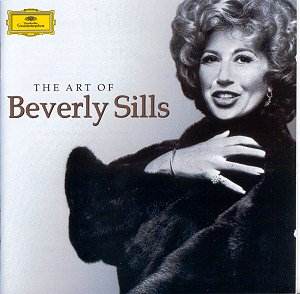Born Beverly Silverman in Brooklyn in 1929 she was
nicknamed ‘Bubbles’ as a child and it stuck, within the trade, throughout
her career. It was a career that started as a child, singing an early
commercial jingle for ‘Rinso’. (Those of ‘a certain age’ will remember
the World War 2 days, when ‘Persil’ and ‘Rinso’ shared Monday’s soapsud
duopoly, at least in the U.K.). By her early teens Sills was having
serious vocal training with a renowned teacher and laying the foundations
to a technique that was to be her mainstay throughout her career. She
made her professional debut in 1947 and then worked and toured with
various U.S. opera companies before making her debut with the New York
City Opera in 1955. She went on to become unofficial prima donna of
the NYCO. However, Sills’ international career did not take off until
that company moved to the Lincoln Center in 1966 where she had a spectacular
success in the florid role of Cleopatra in Handel’s Julius Caesar.
First appearances in Vienna (1967), La Scala (1969) and Covent Garden
(1970) were made to acclaim, but she had to wait until 1975 for setting
foot in her hometown international house, The Met, when they mounted
The Siege of Corinth for her. She later sang Violetta, Lucia,
Thais and Norina there. Throughout her career Sills remained faithful
to the City Opera who mounted many bel-canto works for her, particularly
Donizetti’s Three Tudor Queens. After her retirement from
singing, in 1979, she was, for 10 years, general director of the company.
Sills’ voice was that of a superbly schooled lyric
coloratura soprano, the high notes, and there are plenty on these discs,
are hit not slid up to. Added to that was the singer’s skill as an actress.
On stage, like Callas, she became the part she was portraying. Whereas
Joan Sutherland, who assayed much the same fach contemporaneously
with Sills, had a fuller tone, Sills’ lighter, whiter voice (in no way
meant to be critic-speak for thin or shrill!), with greater clarity
of diction, allied to her histrionic strengths, had an overwhelming
effect in the theatre. Enough of the eulogy, some of which is contained
in English, French and German in the booklet which only otherwise contains
dates of recording, venues, conductors and supporting artists. No attempt
is made to indicate the context of the extracts or give a synopsis;
shame. Except for The Ballad of Baby Doe (disc 2 tr.6) recorded
in 1959, all of the contents are from recital and complete opera albums
recorded between 1969 and 1973. This was the period of the height of
the Sills’ international fame, when there was a rush to get her into
the studio and cash in on the attendant euphoria, particularly in the
U.S.A. In the complete operas recorded by Sills, the ‘supporting’ casts
are of the highest standard; Bergonzi in Lucia, Gedda in Puritani,
heard here (disc 1 tr.8).
In the 2002/03 edition of the DG Catalogue, when the
number but not the title of this disc was settled, the latter is given
provisionally as ‘The Great Beverly Sills’. I am glad that title didn’t
stick. By the highest vocal standards alone Sills’ voice falls short.
Compare her ‘Depuis le jour’ (disc 1 tr.4) with say that of the current
US diva of the day, Renée Fleming, (Decca 458-858 2), and one
can appreciate the benefits of the vocal colour that the younger singer
brings even when there is no failing in Sills’ characterisation. In
the Bellini and Donizetti, the larger part of disc 1, Sills is in her
true metier. The same compelling strengths occur where her recordings
overlap those of Joan Sutherland who had the inestimable benefit of
a consistent partner, Pavarotti, at least in her later versions. Neither
Gedda in the Puritani (disc 1 tr.8) excerpt, or Stuart Burrows
in the Anna Bolena is of that standard. However Sills’ singing
is pure as crystal with the notes hit unflinchingly. She has all the
requisite coloratura ‘needle’, with characterisation good and diction
even better. Certainly, in the latter respects, this is far superior
to that provided by Sutherland.
Disc 2 is more eclectic with arias from Hoffman,
Zaide and by Heuberger, Lehár, Korngold and Richard Strauss
as well as ‘Baby Doe’. The latter, well recorded in 1958, shows the
high level of legato and control that remained with Sills at least through
the period of these recordings. Her Vilja Lied is particularly
enjoyable (disc 2 tr.5) even if her German is not exemplary. From the
same sessions at Croydon’s Fairfield Halls in May 1971, in her interpretation
of Korngold’s Marietta, a quick vibrato, even flutter, is evident
in the voice. Maybe Sills’ normal even legato was tested by Rudel’s
tempi. On this second disc the singer’s strengths seemed out of keeping
with Strauss’s Daphne (tr 8). She is better in the brief Op.19
lied by the same composer (tr.9).
The recordings are all of good standard with the singer
forward of the orchestra and the voice caught in all its purity without
any microphone edge. The conducting too is of a uniformly good standard.
Purchasers will find much to enjoy in this issue and I hope to see it
featured in future issues of DG’s catalogue for some years to come.
Sills’ complete recordings of the Donizetti ‘Queens’, Puritani and
Lucia were only indicated as issued on CD in Britain in the autumn
of 2001 and summer 2002, yet they do not feature in that catalogue nor
do I see them when browsing in superstores; ominous? Certainly, Sills’
recordings are, in my view, preferable to the similarly clear toned
Gruberova on the ‘Nightingale’ label particularly in respect of ‘supporting’
casts. I can but hope that the Sills versions haven’t disappeared into
the ether, or more realistically, into the bowels of the Universal Archive
to emerge only at some anniversary or lamentable event.
Robert J Farr

